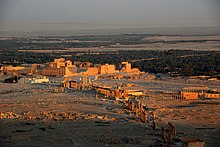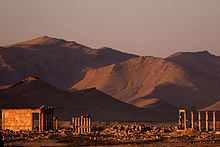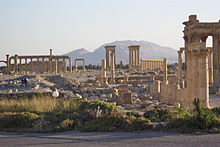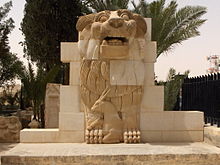Palmyra
![]()
The title of this article is ambiguous. For other meanings, see Palmyra (disambiguation).
34.559166666738.2736111111Coordinates: 34° 34′ N, 38° 16′ E
Palmyra (Latinized form of ancient Greek Παλμύρα, Palmýra (f. sg.); Arabic تدمر Tadmur; Aramaic ܬܕܡܘܪܬܐ Tedmurtā; Hebrew תדמור Tadmor), currently also called Tadmor, is an ancient oasis city in the present-day Homs governorate of Syria. It is located on the territory of the modern city of Tadmor, which had about 51,000 inhabitants before the Syrian Civil War.
The first archaeological finds were from the Neolithic period. The first written mention of the city itself was in ancient Near Eastern times: it was mentioned in the annals of several Assyrian kings and in the Old Testament. Palmyra was later part of the Seleucid Empire and experienced its heyday after annexation by the Roman Empire in the 1st century A.D. Palmyra had a certain autonomy within the Roman Empire and became part of the province of Syria. The metropolis had its own senate, responsible for public works and the local militia, and an independent tax system. In the 3rd century it was elevated to colonia status. During the imperial crisis of the 3rd century, the city gained much political importance and briefly became independent in 270. The city's empire represented a significant power factor in the Near East. However, Palmyra was recaptured by Roman troops in 272 and largely destroyed in 273 after a failed second rebellion.
Palmyra was located on an important caravan route in Syria, halfway from Damascus via the Roman oasis of Al-Dumair and further on via the fort of Resafa to the Euphrates. In the midst of the Syrian desert, two springs provide water to irrigate the still-preserved palm gardens to the south and east of the city. The wealth of the city allowed the construction of monumental building projects. By the third century, the city was a prosperous metropolis and had risen to become a regional center of the Middle East. The Palmyrians were among the renowned merchants, establishing stations along the Silk Road and trading throughout the empire. The social structure of the city was tribal and its inhabitants spoke a distinct language, the Palmyrene dialect of Aramaic. Greek was used for commercial and diplomatic purposes. The culture of Palmyra, influenced by the Romans, Greeks and Persians, is unique in the region. The inhabitants worshipped local deities and Mesopotamian and Arab gods.
The city has been part of Syria as an independent state since the expulsion of the Ottomans in 1918. Today, it is home to distinctive art and architecture and was declared a UNESCO World Heritage Site in 1980. In May 2015, members of the terrorist organization Islamic State (IS) captured Palmyra and subsequently blew up significant historic structures; the site was also looted. In March 2016, Syrian forces temporarily regained control of Palmyra with Russian support, but in December 2016, IS fighters again invaded Palmyra after fierce fighting. In March 2017, IS had to vacate the city again for a second time.

Overview of Palmyra (2008)

Palmyra seen from the north (2008)
Location and etymology
Palmyra is located 215 km (134 miles) northeast of the Syrian capital Damascus. The ruined city is located in an oasis surrounded by palm trees (about 20 different varieties). It is located in the center of the Aleppo highlands and is enclosed to the north and southwest by two mountain ranges. To the south and east, Palmyra is surrounded by the Syrian Desert. A small wadi (al-Qubur) crosses the area before flowing into the eastern gardens of the oasis from the western hills behind the city. South of the wadi flows the tributary stream Efqa. Pliny the Elder praised the city around c. 70 for its location, the richness of the soil, and the fields on the outskirts of the city that had made agriculture and livestock raising possible in the past.
The word Tadmor (in Palmyrene inscriptions tdmry or tdmwry) has an Old Semitic origin, the Greek name Palmyra refers to the vegetation of the oasis (figuratively "palm city"). Today it is generally believed that Palmyra derives from Tadmor. Tamar means "date palm" in Hebrew and, according to legend, was the name of a city founded by Solomon; this reference to the name was transferred to the oasis settlement of Tadmor.
The name Palmyra first appeared at the beginning of the first century AD and was used throughout the Roman Empire; however, the name form Tadmor continued to be used in Palmyra itself. The U.S. archaeologist Michael Patrick O'Connor claimed that Palmyra and Tadmor come from Hurrian. In this he makes a connection between the Hurrian verbs pal (to know) and tad (to love). In the thirteenth century, the Syriac geographer Yāqūt ar-Rūmī wrote that Tadmor had been the name of a daughter of one of Noah's distant descendants and that she was buried in the city.

Landscape in and around Palmyra (2005)
Current state
The city was developed for tourism before the 2015 fighting in Syria, there were good bus connections and several hotels. Since 1980, the ruins have been a UNESCO World Heritage Site.
In the civil war in Syria since 2011 - including the fighting by the Islamic State (IS), which destroys cultural property for ideological reasons (see also Iconophobia) - the site is increasingly threatened by looting. UNESCO has placed it on the Red List of World Heritage in Danger. Palmyrene funerary reliefs are highly sought after in collector circles and are exported illegally. By removing the objects from their context, valuable data for historiographical evaluation is lost, which could help answer the question of the economic and social conditions of Palmyrene's rise.
On the evening of May 20, 2015, Syrian government forces and militiamen cleared the city of Tadmor. Thus, the archaeological site also passed into the hands of IS. The director of the Syrian Antiquities Administration said that the objects housed in the Palmyra museum had been moved to safety. On June 21, 2015, reports from Syria went public that IS had installed land mines and explosive devices around the ancient ruins in Palmyra. However, it was unclear whether the explosive devices were planted to defend Palmyra against Syrian government forces, who may have been planning an offensive, or to destroy the temple complexes.
Maamun Abdelkarim, head of the Syrian Antiquities Collections, described the June 27, 2015 destruction of the famous lion sculpture from the Allat Temple, which was discovered in 1977 and stood at the entrance to the Palmyra Museum, as "the worst crime committed by the jihadists against the heritage of Palmyra." The destruction is condemned worldwide.
On August 25, 2015, the temple of Baalshamin was destroyed by the IS militia. On August 31, 2015, the IS militia also reportedly carried out a blast at the Temple of Baal, causing severe damage to it. Shortly thereafter, the United Nations confirmed the destruction based on satellite imagery. In early October, the terrorists blew up the Arch of Triumph (Hadrian's Gate) on the city's boulevard.
In March 2016, troops of the Syrian army, supported by militias loyal to the government and in particular by the Russian air force, succeeded in liberating parts of the city from IS. Tactically important high ground had already been taken by them some time earlier, including the old citadel of Palmyra, which the IS lost with heavy losses. On March 27, 2016, the Syrian army announced the complete recapture of Palmyra.
Initially, there was confidence that a significant part of the blown-up structures of Palmyra could be reconstructed. In May, the recapture of the city was celebrated with a classical concert in front of the ruins. However, on December 10, 2016, in a surprise offensive, IS fighters managed to retake Palmyra. On January 20, 2017, further destruction in the ancient city by IS became known. This affected the tetrapylon and the stage of the theater.
On March 1, 2017, Syrian troops advanced on Palmyra Castle. On March 2, 2017, the city was again in the hands of Syrian troops, according to Russian sources. However, as the Islamists had left behind numerous booby traps, the Syrian army was slow to move back into Palmyra.
In 2017, various faculties of the University of Konstanz reconstructed the original state of the ruins in a model and presented this in an exhibition.

Lion sculpture from the Allat Temple, 1st century B.C. (2010)
_10.jpg)
Russian troops searching for booby traps and mines in April 2016
Search within the encyclopedia